The theme puja I covered on 100 years of Bengali Cinema has been awarded the best creative pandal in Delhi NCR.
Kudos to the entire team of Prantic Cultural, Indirapuram.
And a special thanks to Tapash Maity, the artist, for spending so much time with me.
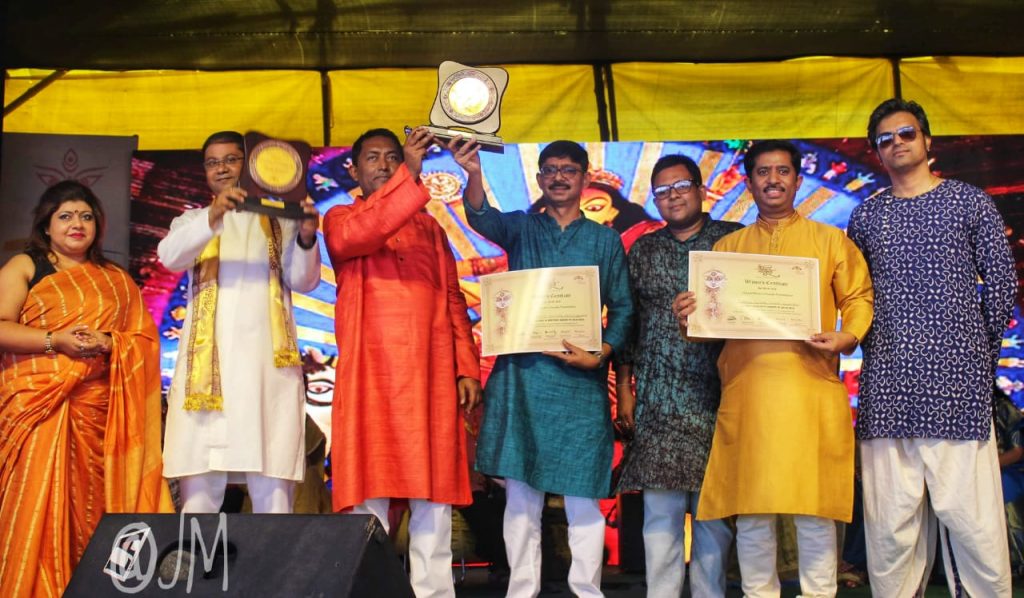

That’s one update I had to make upfront. Now for the ‘making’ story…
NOSTALGIA REVISITED
Nostalgia is a way of life for immigrants. I can tell that from personal experience.
Durga Puja, or for that matter any Community Puja during our childhood days, used to be largely a neighbourhood affair in suburban West Bengal. The seniors will take up Durga Puja, the youth will make do with Kaali puja, and for us children, Saraswati was the only outlet left to feel like an adult.
Much of the work we did ourselves in our impromptu puja pandals, including cutting bamboo from the boughs of non-cooperative owners, soaking them in pond water and drying them in the open, cutting them to create brackets that fit with each other and setting up small pandals, tying tight with jute ropes. Then came the ‘theme’ – lots of paper and thermacol cutting and pasting and coloring.
It was much like a large scale craft project. The more enthusiastic ones (usually they would be the most bankrupt ones as well) even built the Saraswati ‘protima’ (idol), right from the ‘kathamo’ (structure), and upwards.
Most didn’t look much like Ravi Verma’s Saraswati, but who cares. We didn’t.
I was also fortunate to spend around five years in a locality called Kakinada, a suburban industrial town near Kolkata. The town had a vantage position between Naihati and over the Ganges Chadannagore. These two places have a special place in my early childhood memories. Naihati, for its gigantic Kaali idols; and Chandannagore for its resplendent Jagadhatri pujo fanfare, all lit up with innovative lightworks.
MAKING OF A THEME DURGA PUJA PANDAL
Right from those salad days, I have held the ‘pandal’ artists in high esteem. The way they spend months to create gigantic structures out of nothing, and that too for a extravaganza that’s best described as temporary, is nothing less than awe inspiring.
I often used to stand and watch them work late into the night. I wanted to be like them.
That wonder has stayed on, all these years.
When I heard that Prantic Cultural Society at Indirapuram, Delhi NCR, has decided to create a theme pandal on the 100 years of Indian Cinema, there was no looking back for me. That’s a double bonanza on two things I love. I had to map its journey.
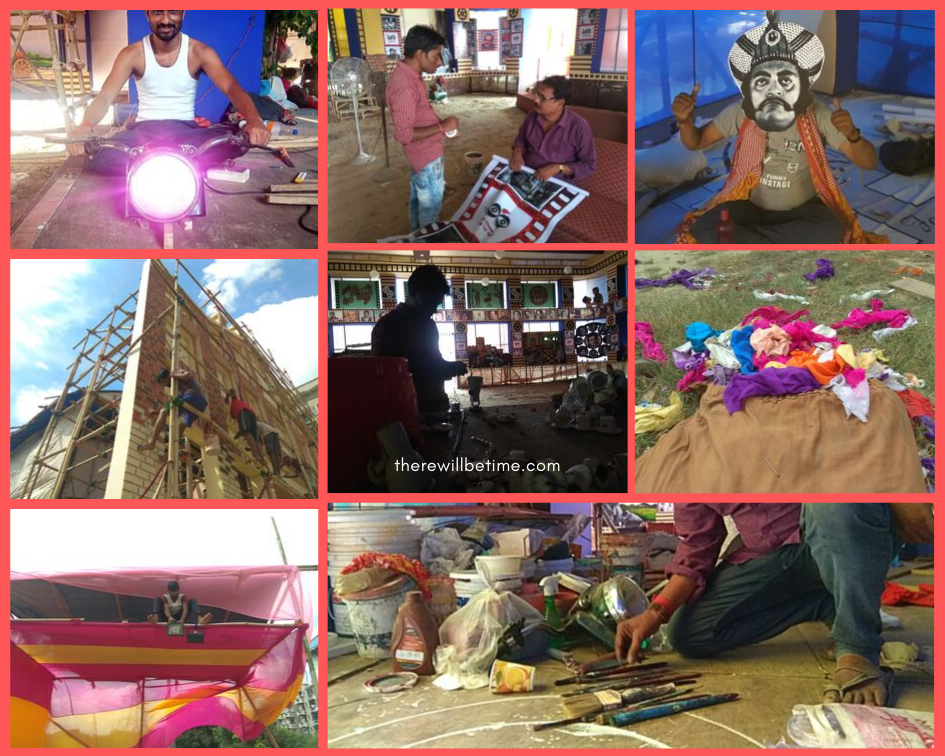
FROM SAPTAPADI IN KOLKATA TO PRANTIC IN INDIRAPURAM
Like I said, nostalgia is a way of life for us. It’s how we negotiate our past.
The idea, by his own admission, came to Abhijeet Roy, President of Prantic Cultural Society, when he was gorging upon Bengali delicacies at a Kolkata Restaurant called “Saptapadi”. It’s a theme restaurant, intelligently named to both evoke the “Uttam Suchitra” nostalgia and refer to a saptapadi (seven-course) meal.
Abhijit loved the décor and the idea behind the restaurant, and since it was the 100 years of Bengali Cinema as well, wanted a theme-pujo around that.

But you can’t just want something and get it in a “baaro-yaari” (community) pujo. Three concepts were proposed to the theme committee. A Shantiniketan inspired ‘maatir-taane’ (call of the earth) theme, a gender theme depicting ‘Narishakti’ (woman power) and this – ‘100 Years of Bengali Cinema’. This won the pitch.
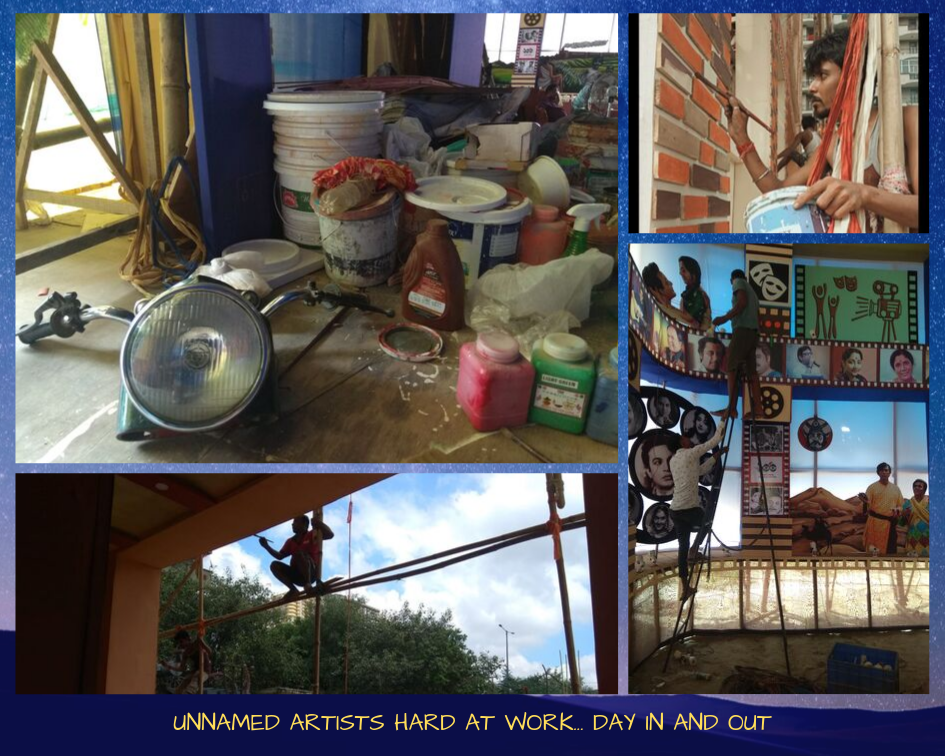
to these people …and their largely unrecognized craftsmanship
THIS ‘PANDAL’ ARTIST IS A MAN OF MANY TALENTS
Up next, the artist was contacted and the theme explained. The chief artist, Tapash Maiti, has been doing theme pandals since 2005, and Prantic pandals since 2016.
Tapash is a trained Commercial Artist from the Academy of Fine Arts, Kolkata. Originally from Howrah district in West Bengal, he has a home in Kolkata’s Dhakuria as well; and when he is not making pandals or doing illustrations and designs for advertising agencies, he does show-anchoring as an emcee. He also illustrates stories for and by children in the Biswa Bangla app – a mobile based learning platform.
He even indulges a bit in writing – poems and all . Here, he has also lent his voice to the theme-narrative that will run as a backdrop inside the pandal.
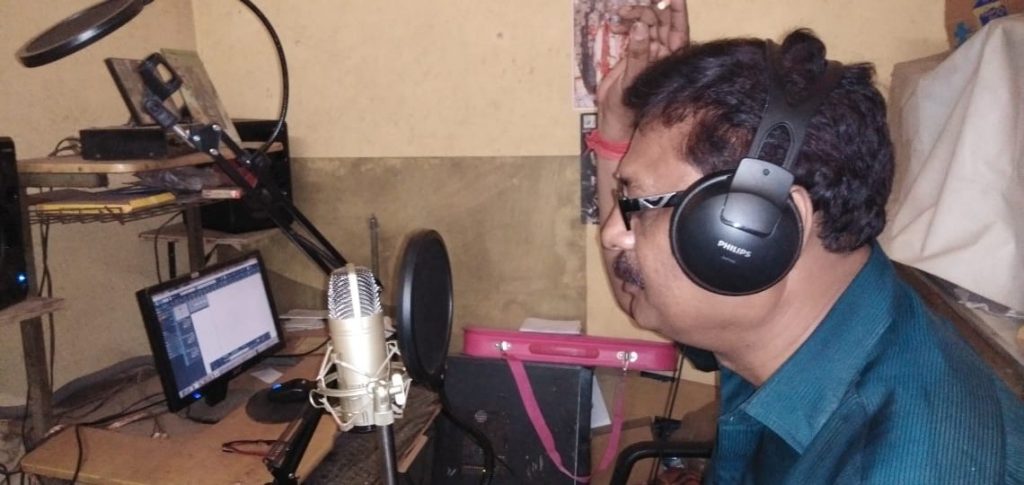
IT’S MUCH LIKE MAKING FILMS
The first step after the idea gets decided is lots of ‘mood-boards’, much like the storyboards we create while making an ad-film.
To draw a parallel with screenplays, this is the stage when you sketch the ‘characters’ and create the basic ‘story-flow’. Most of this first draft is done at one go, with the artists imagination running free. Then comes a phase where you add elements to this first draft, design the soundscape, decide on the sub-stories etc.

After the basics, comes the fleshing-out part. This is where, while maintaining the structure, you improve on the original idea.
Once again, like a screenplay. There will always be afterthoughts that improve on the viewer experience. The ‘idea’ here was to replicate the mood of an old-world Cinema Theater – hence those wooden girders on the roof was an original idea, from the beginning; putting a live projector on display came later as an additional input.
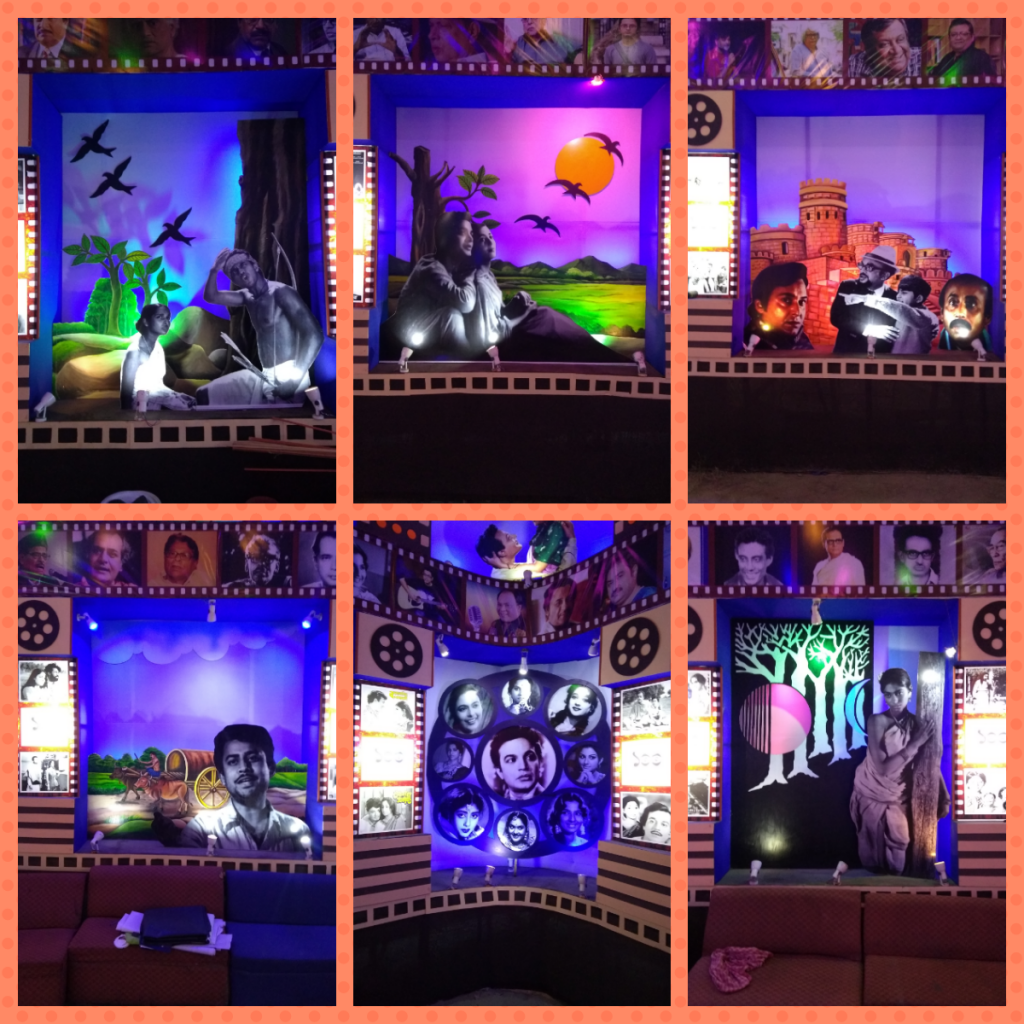
I mean, Jatayu is looking like he is straight out of an existential horror flick…
It takes time to create such ‘theme’ pandals. Each of the panels we see here consist of painstakingly hand-painted ply-board backdrops and cutouts. Imagine the time spent in creating each of them, setting them up, and lighting them just right to create a 3D like effect. This is quite small scale; multiply this manifold for prime Kolkata Pujo’s, where many more people and much larger budgets are involved. It’s crazy !
The exterior in this case is uni-dimensional, designed like the façade of a single-screen theater hall of yesteryear. The pathways have posters in lamp-posts – that’s a cute touch. Even more eyeballs-grabbing is the ‘Uttam-Suchitra’ cutout at the gate, complete with the handle of a Bullet Bike, with a lighted head-light to complete the scene.

For the interiors, Tapas told me that for this particular case he had to keep in mind the flow of the people entering the pandal; much like a museum or an art gallery, he has set a visual-flow to guide their experience. So the panels are organized with a particular storytelling idea in mind – what should the viewer see first, and then where should he go next emotionally, and this continues till the exit gate.
It’s a challenge, no doubt.
it’s about 100 years of Bangla Cinema, so what to take and what not to? Sometimes the artists vision works, but then, known faces and popular names often get more ‘screen-space’ – on public demand. I mean, its okay being Tapan Sinha or Rajan Tarafdar or even Mrinal Sen, but you have to be Satyajit Ray to have 6 out of 10 main panels all to yourself. But Ray is Ray, and Bongs are Bongs – what to do?
And why ‘Mrigyaa’ for that matter – I believe some Bengali language films of Mrinal Sen might have had equal viewer recall. And yes, I would have loved a caged board with wire mesh at the entrance lane, with pictures of a ‘now showing’ film on it. Loved to see them as a child. That would had been a nice touch.
Naah, I am not complaining; just observing. I absolutely love what they have done.
And it’s well understood that a large number of considerations and deliberations go behind such ambitious ‘thematic’ expressions, which makes the experience even more priceless and personal. You definitely can’t make everyone happy when you are attempting something of this scale.
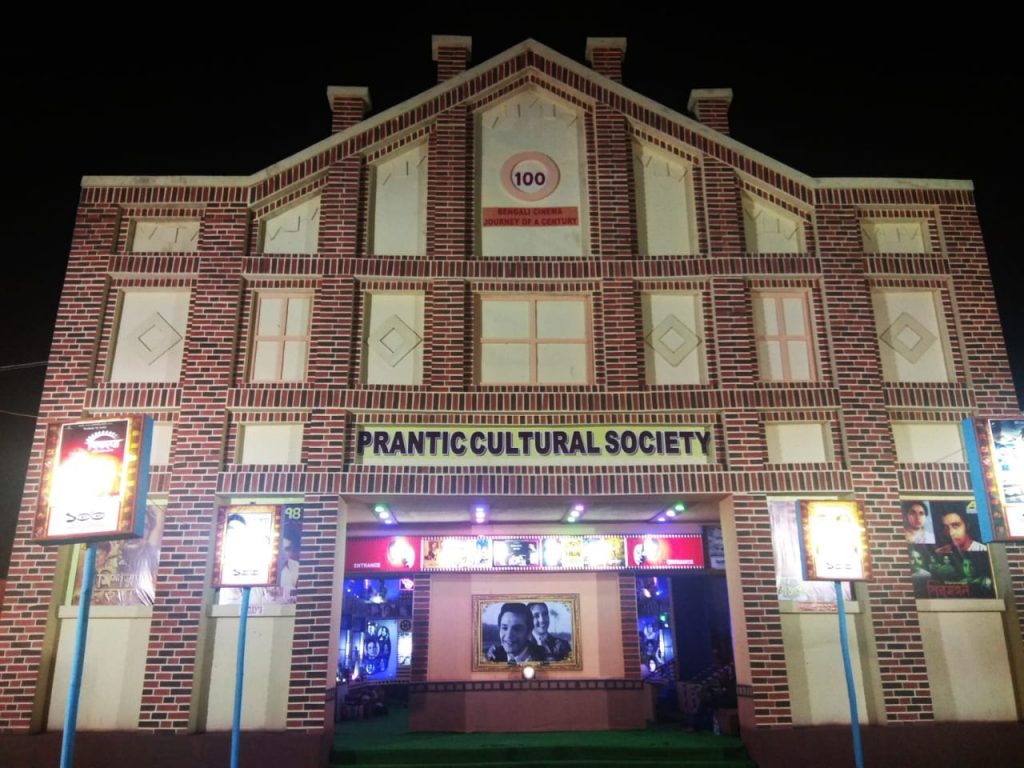
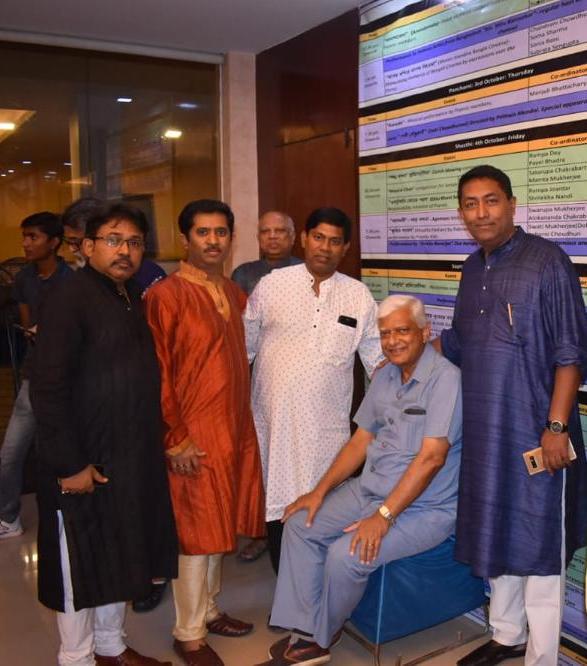
Extreme left, Abhijit Roy, President. By his side Rajiv Roy, Coordinator for Cultural Activities and Promotions. On the extreme right, Vice President, Niladree Deb Chowdhury.
On that note of conviction and positivity, no more nitpicking…
More so because I am expecting to go there again on Navami night, when the entire R D Burman gang of musicians will be performing at Prantic. Hope therewillbetime for that – it should be another experience to cherish for a long time to come.


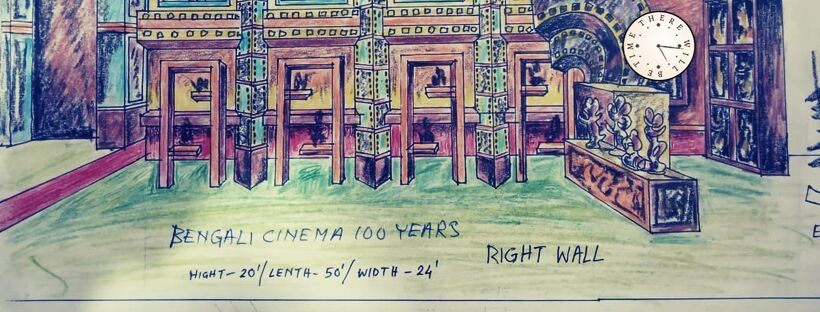
The past couple of years have seen an increasing number of professionally trained artists joining the pandal-making fray- what with puja organisers roping in arts and film personalities, as well as architects, interior designers and even movie set designers!